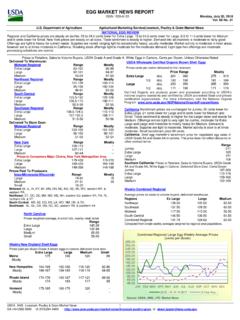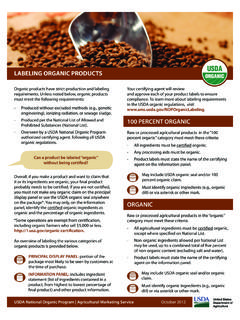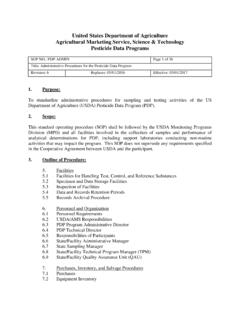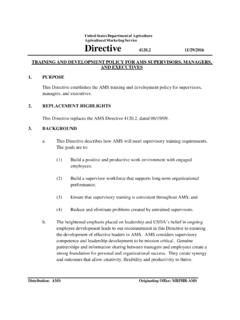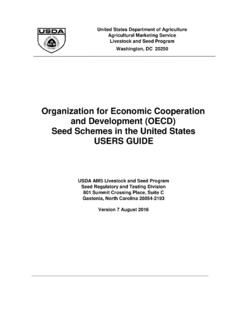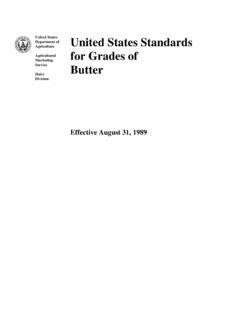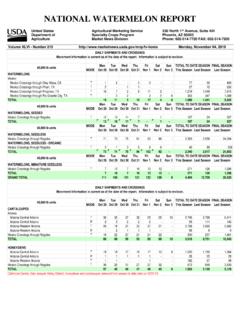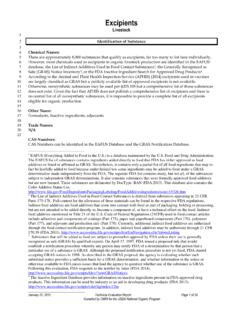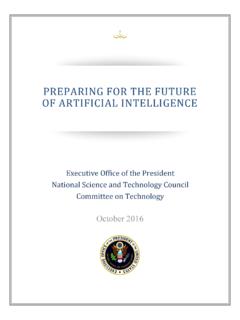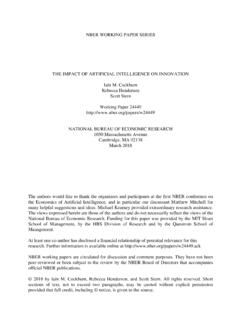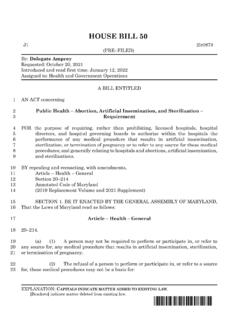Transcription of OVERVIEW OF FLAVOR ADDITIVES
1 1 OVERVIEW OF FLAVOR ADDITIVES 1 Prepared for the USDA National Organic Program and 2 the National Organic Standards Board 3 October 14, 2005 4 5 6 This paper provides a general characterization of FLAVOR ADDITIVES , including an OVERVIEW 7 of how they are regulated within the United States and how they are currently used in 8 organic food production. 9 10 I. EXECUTIVE SUMMARY 11 12 Flavors are volatile organic chemicals. Most have simple, well-characterized structures 13 with a single functional group ( , a chemically reactive subunit) and a low molecular 14 weight. Flavors can be categorized as artificial flavors, spices, and natural flavors. 15 Flavors are regulated by the Food and Drug Administration (FDA) in the United States 16 and are either generally recognized as safe (GRAS) substances or food ADDITIVES , which 17 need to be approved by FDA. Manufacturers that produce flavors that are considered 18 food ADDITIVES must submit petitions to FDA containing specific information so that the 19 favors can be evaluated for safety when consumed by humans.
2 Although FDA regulates 20 whether flavors are safe for human consumption, they are also of interest to other 21 governmental bodies. Currently, the USDA and the National Organic Standards Board 22 (NOSB) are evaluating the use of natural flavors in organic foods or foods made with 23 organic ingredients. 24 25 II. CHARACTERIZATION 26 27 Approximately 2,500 chemically defined flavoring substances are in use in either Europe 28 or the United States (Munro et al., 1999). These substances are all volatile organic 29 chemicals, and most have simple, well-characterized structures with a single functional 30 group ( , alcohol, ketone) and a low molecular weight (<300 g/mol). Aliphatic acyclic 31 and acyclic alcohols, aldehydes, ketones, carboxylic acids and related esters, lactones, 32 ketals, and acetals comprise more than 700 of the 1,323 chemically defined flavoring 33 substances in the United States.
3 Additional structural categories include aromatic, 34 heteroaromatic, and heterocyclic substances with characteristic organoleptic properties 35 (Munro et al., 1999). 36 37 Flavors can further be characterized as artificial flavors, spices, or natural flavors. 38 According to FDA (21 CFR Part 101), artificial flavors, spices, or natural flavors are 39 defined as follows: 40 41 artificial FLAVOR or artificial Flavoring: ..any substance, the function of which is to 42 impart FLAVOR , which is not derived from a spice, fruit or fruit juice, vegetable or 43 vegetable juice, edible yeast, herb, bark, bud, root, leaf or similar plant material, meat, 44 fish, poultry, eggs, dairy products, or fermentation products thererof. 45 46 2 Specific artificial flavors are listed in 21 CFR Parts and 1 2 Spice: ..any aromatic vegetable substance in the whole, broken, or ground form, except 3 for those substances which have been traditionally regarded as foods, such as onions, 4 garlic, and celery; whose significant function in food is seasoning rather than nutritional; 5 that is true to name; and from which no portion of any volatile oil or other flavoring 6 principle has been removed.
4 7 8 Specific spices are listed in 21 CFR Parts and 184. 9 10 Natural FLAVOR : ..the essential oil, oleoresin, essence or extractive, protein 11 hydrolystate, distillate, or any product of roasting, heating or enzymolysis, which 12 contains the flavoring constituents derived from a spice, fruit or fruit juice, vegetable or 13 vegetable juice, edible yeast, herb, bark, bud, root, leaf of similar plant material, meat, 14 seafood, poultry, eggs, dairy products, or fermentation products thereof, whose 15 significant function in food is flavoring rather than nutritional. 16 17 Natural flavors include the natural essence or extractives obtained from plants listed in 21 18 CFR Parts , , and , as well as those listed in Parts 184 and 19 20 According to a study by Munro et al. (1998), human exposure to flavors is generally low 21 in the United States. Exposure levels estimated by Munro et al. (1988) are shown in 22 Table 1.
5 These estimates were made with the following assumptions: (1) survey 23 poundage reflects 60 percent of actual use, (2) 10 percent of the population is exposed, 24 and (3) the population in 1987 was 240 million. 25 26 Table 1: Human Exposure to FLAVOR Ingredients a (Munro et al., 1998) 27 Intake ( g per day)b Number of Flavors Cumulative Frequency (%) < 349 26 93 33 274 54 1-10 224 71 10-100 204 86 100-1000
6 111 95 1000-10,000 45 98 10,000-100,000 16 99 >100,000 7 100 Total 1,323 100 a Chemically defined flavoring substances permitted for use in the , excluding botanicals. 28 b Intake ( g/person/day) = ([annual FLAVOR usage in ]/24) X 106 persons X 365 days 29 30 III.
7 REGULATION 31 32 Currently in the United States, flavors are regulated by FDA under authority of the Food 33 ADDITIVES and Amendment Act (FAA) of 1958. Under the FAA, FDA is responsible for 34 ensuring the safety of new food ADDITIVES , including flavors, before they are used in food 35 3products. In the existing regulatory system, all flavors are either GRAS ( generally 1 recognized as safe ) substances or FLAVOR ADDITIVES that must be approved for use by 2 FDA. 3 4 A. GRAS Flavors 5 6 In response to the FAA, the FLAVOR and Extract Manufacturers Association of the United 7 States (FEMA) was formed, and the GRAS assessment program was initiated. This 8 assessment program was created because the lengthy new food additive application 9 process was considered unnecessary for the large number of substances with a long 10 history of widespread and apparently safe use. Food Additive Petitions and approval by 11 FDA (see Section III.)
8 B.) are not required for GRAS substances. 12 13 FEMA consists of a panel of independent experts who are responsible for establishing 14 procedures that help decide whether a FLAVOR qualifies as a GRAS substance and applying 15 these procedures to the safety evaluation of FLAVOR materials being used in the United 16 States. In order to qualify as a GRAS substance, a FLAVOR must meet the following four 17 requirements (Hallagan and Hall, 1995): 18 19 1. Safety must be generally recognized by experts. 20 21 2. Experts must be qualified by scientific training and experience in evaluating 22 safety. 23 24 3. Experts must base their decisions on scientific procedures or through experience 25 based on common use in food if used in food prior to 1958. 26 27 4. Determination of a GRAS substance must be based, in part, on the intended 28 conditions of use of the flavoring substance through the calculation of a possible 29 average daily intake and a per capita exposure estimate.
9 30 31 To date, there are more than 2,000 materials judged to be GRAS substances by FEMA 32 (Adams and Smith, 2004). 33 34 FDA recognizes the work of FEMA and incorporates information provided by the expert 35 panel on the safety of flavoring substances into FDA s FLAVOR database. Additionally, in 36 1976, FDA recognized the FEMA GRAS lists when giving their opinion on bulk labeling 37 of flavors and in other direct ways (Hallagan and Hall, 1995). Currently, FDA s safety 38 requirements for GRAS substances largely depend on the FLAVOR s historical profile. 39 Affirmation of GRAS status is often based on the common use of the substance in foods 40 prior to 1958 coupled with the lack of known or documented adverse effects. This 41 statement is supported by Section of the CFR. Those substances with no 42 documented history prior to 1958 may still qualify as a GRAS substance by FDA; 43 however, the quantity and quality of scientific evidence required is the same as that for a 44 food additive petition.
10 Affirmed GRAS substances that are to be used in new ways or at 45 different concentrations also must have their status re-evaluated by FDA. Like FEMA, 46 4 FDA affirms GRAS substances by using an expert advisory panel that reviews the 1 scientific data. Substances lacking strong scientific evidence may be deemed a food 2 additive and subjected to a food additive petition. 3 4 B. Flavors Regulated as Food ADDITIVES 5 6 If a FLAVOR does not qualify as a GRAS substance, a food additive petition must be filed 7 by the petitioner and approved by FDA. In filing for a food additive approval, the 8 petitioner is responsible for providing FDA with information including, but not limited to 9 the following: 10 11 Identification of the food additive; 12 Physical, chemical, and biological properties; 13 Chemical specifications; 14 Manufacturing process description; 15 Stability data; 16 Intended uses and restrictions; 17 Labeling1; 18 Tolerances limitations2; 19 Analytical methods for enforcing chemical specifications; 20 Safety studies; and 21 Estimate of probable exposure.
